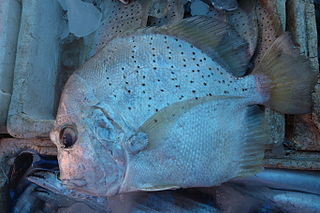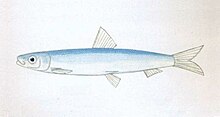
The Tetraodontiformes are an order of highly derived ray-finned fish, also called the Plectognathi. Sometimes these are classified as a suborder of the order Perciformes. The Tetraodontiformes are represented by 10 extant families and at least 349 species overall; most are marine and dwell in and around tropical coral reefs, but a few species are found in freshwater streams and estuaries. They have no close relatives, and descend from a line of coral-dwelling species that emerged around 80 million years ago.

Catfish are a diverse group of ray-finned fish. Named for their prominent barbels, which resemble a cat's whiskers, catfish range in size and behavior from the three largest species alive, the Mekong giant catfish from Southeast Asia, the wels catfish of Eurasia, and the piraíba of South America, to detritivores, and even to a tiny parasitic species commonly called the candiru, Vandellia cirrhosa. Neither the armour-plated types nor the naked types have scales. Despite their name, not all catfish have prominent barbels or "whiskers". Members of the Siluriformes order are defined by features of the skull and swimbladder. Catfish are of considerable commercial importance; many of the larger species are farmed or fished for food. Many of the smaller species, particularly the genus Corydoras, are important in the aquarium hobby. Many catfish are nocturnal, but others are crepuscular or diurnal.

Sciaenidae is a family of ray-finned fishes belonging to the order Acanthuriformes. They are commonly called drums or croakers in reference to the repetitive throbbing or drumming sounds they make. The family consists of about 293 to 298 species in about 66 or 67 genera.

Clupeiformes is the order of ray-finned fish that includes the herring family, Clupeidae, and the anchovy family, Engraulidae. The group includes many of the most important forage and food fish.

Carp are various species of oily freshwater fish from the family Cyprinidae, a very large group of fish native to Europe and Asia. While carp is consumed in many parts of the world, they are generally considered an invasive species in parts of Africa, Australia and most of the United States.

Cypriniformes is an order of ray-finned fish, including the carps, minnows, loaches, and relatives. Cypriniformes is an Order within the Superorder Ostariophysi consisting of "Carp-like" Ostariophysins. This order contains 11-12 families, although some authorities have designated as many as 23, over 400 genera, and more than 4,250 species, with new species being described every few months or so, and new genera being recognized frequently. They are most diverse in southeastern Asia, and are entirely absent from Australia and South America. At 112 years old, the longest-lived cypriniform fish documented is the bigmouth buffalo.

Swordfish, also known as broadbills in some countries, are large, highly migratory predatory fish characterized by a long, flat, pointed bill. They are a popular sport fish of the billfish category, though elusive. Swordfish are elongated, round-bodied, and lose all teeth and scales by adulthood. These fish are found widely in tropical and temperate parts of the Atlantic, Pacific, and Indian Oceans, and can typically be found from near the surface to a depth of 550 m (1,800 ft), and exceptionally up to depths of 2,234 m. They commonly reach 3 m (10 ft) in length, and the maximum reported is 4.55 m in length and 650 kg (1,430 lb) in weight.

The Squaliformes are an order of sharks that includes about 126 species in seven families.

The Amazon basin is the part of South America drained by the Amazon River and its tributaries. The Amazon drainage basin covers an area of about 6,300,000 km2 (2,400,000 sq mi), or about 35.5 percent of the South American continent. It is located in the countries of Bolivia, Brazil, Colombia, Ecuador, Guyana, Peru, Suriname, and Venezuela, as well as the territory of French Guiana.

The Ginglymostomatidae are a cosmopolitan family of carpet sharks known as nurse sharks, containing four species in three genera. Common in shallow, tropical and subtropical waters, these sharks are sluggish and docile bottom-dwellers. They are the most abundant species of shark found in shallow coastal waters. Nurse sharks typically attack humans only if directly threatened.

The South American lungfish, also known as the American mud-fish and scaly salamanderfish. is the single species of lungfish found in swamps and slow-moving waters of the Amazon, Paraguay, and lower Paraná River basins in South America. Notable as an obligate air-breather, it is the sole member of its family Lepidosirenidae, although some authors also place Protopterus in the family. In Brazil, it is known by the indigenous language Tupi name piramboia, which means "snake-fish", and synonyms pirarucu-bóia, traíra-bóia, and caramuru.

The Moronidae is a family of percomorph fishes, commonly called the temperate basses, in the order Moroniformes. These fishes are found in the freshwaters of North America and the coastal waters of the North Atlantic.

Holocentridae is a family of ray-finned fish, the only family of the order Holocentriformes. The members of the subfamily Holocentrinae are typically known as squirrelfish, while the members of Myripristinae typically are known as soldierfish. In Hawaii, they are known by the Japanese name mempachi/menpachi (メンパチ) or the Hawaiian ʻūʻū.

Ephippidae is a family of percomorph fishes, the spadefishes, in the order Moroniformes. These fishes are found in the tropical and temperate oceans of the world, except for the central Pacific.

Drepane is a genus of marine and brackish water ray-finned fishes, known commonly as the sicklefishes. It is the only genus in the monotypic percomorph family Drepaneidae. These fish occur in the Indian and western Pacific Oceans, and in the eastern Atlantic near Africa.

Fish are aquatic, craniate, gill-bearing animals that lack limbs with digits. Included in this definition are the living hagfish, lampreys, and cartilaginous and bony fish as well as various extinct related groups. Approximately 95% of living fish species are ray-finned fish, belonging to the class Actinopterygii, with around 99% of those being teleosts.

Spratelloides is a genus of fish in the family Spratelloididae. They are small fish used as fishing bait, especially in skipjack tuna-fishing. Some species are also valued as food in certain countries, like Spratelloides gracilis, known as kibinago in Japan.
SeaLifeBase is a global online database of information about marine life. It aims to provide key information on the taxonomy, distribution and ecology of all marine species in the world apart from finfish. SeaLifeBase is in partnership with the WorldFish Center in Malaysia and the UBC Institute for the Oceans and Fisheries at the University of British Columbia. Daniel Pauly is the principal investigator and it is coordinated by Maria Lourdes D. Palomares. As of March 2023, it included descriptions of 85,000 species, 59,400 common names, 15,500 pictures, and references to 39,300 works in the scientific literature. SeaLifeBase complements FishBase, which provides parallel information for finfish.
Rainbow Fish is a 2000 British animated children's television series adapted from the book of the same name by Marcus Pfister. Unlike the book, the television adaptation didn't follow the plot; instead, it takes the character and the setting and creates a new story with them, with some characters being added and others embellishing for the purposes of the series, in which the place where the fish live is called "Neptune Bay", with the fish mostly attending "The School of Fish". It also features a shipwreck called "Shipwreck Park". The series was produced by Decode Entertainment and EM.TV in association with Sony Wonder.

















